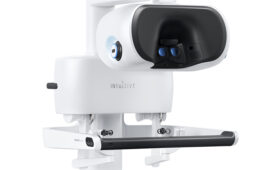Manufacturers of Class I reusable (Class Ir) medical devices need to identify data gaps and select the appropriate validation study to ensure their devices’ compliance with the European Commission’s Medical Device Regulation (MDR).
Dan Fowler, WuXi AppTec

[Image courtesy of Google Satellite]
The changes
Class Ir devices are designed to be used more than once and across patients. To obtain a CE Mark under MDR, these devices will require a detailed technical file that proves safety and efficacy of cleaning, disinfection and sterilization methods outlined in the device’s Instructions for Use (IFU). Historically, Class I devices, including reusable products, were self-designated, leaving it up to device manufacturers to decide what a validation entailed. But under MDR, every device manufacturer will be responsible for ensuring cleaning, disinfection and sterilization instructions are adequate and validated. A notified body will review the technical files, including these validations, to confirm they comply with MDR and are acceptable according to international standards and industry guidance.
As the May 26, 2020 deadline draws near, it is important to note that reusable devices won’t have the luxury of receiving an extension or being grandfathered in. Therefore, prioritize them early, starting by conducting a gap analysis and appropriate validation studies.
Conduct a gap analysis
Before investing time and money on testing, perform a gap analysis to determine where deficiencies exist in your data and product portfolios. Notified bodies will not rely on historic product performance or reviews alone.
Start by reviewing the technical files for your current Class Ir devices to identify missing information or outdated test strategies. This is especially important for MDR compliance, as you will need to confirm that validations exist in the design file that support instructions for use (IFU) claims and meet current ISO standards, including ISO 17664:2017.
Begin with legacy devices, as those have been on the market longer and will likely take more time. If a product family consists of multiple catalog numbers and SKUs, you must document validation evidence across all of the devices.
Prepare for testing
If the analysis identifies data gaps, run a validation test to rectify them and gather new data or supplemental information. This process can be laborious, but working with a contract research organization (CRO) or laboratory testing partner may help. They can identify and perform appropriate tests to ensure compliance. It is also helpful to identify a partner that can develop experimental design and validation methods that are compliant with the latest guidance and regulatory documents.
Conduct testing
If validation testing is required, start by identifying the type of study or studies needed for your product or product family. Then, validation protocols are developed and customized to your product, its IFU and worst-case conditions. Here are some examples of the studies that may be needed:
• A cleaning efficacy study validates the efficacy of your recommended cleaning process. It requires that you test devices with clinically relevant artificial soils and other worst-case parameters that confirm the process is reliable and repeatable and ensures that clean endpoints are met.
• Sterilization efficacy studies are used to verify that the sterilization methods successfully achieve a targeted sterility assurance level (SAL), even in worst-case scenarios.
• Dry time validations studies are needed because healthcare facilities must know the effective dry time for devices sterilized using steam. It will be important to have data to back that the drying cycle works according to the given parameters.
• Support functionality studies by exposing devices to multiple cleaning, disinfection and/or sterilization cycles beforehand.
• Disinfection efficacy studies will produce documentation showing that selected disinfectants can reduce microorganisms to acceptable levels on the medical device. It is important to note that a cleaning validation and its construct is separate from a disinfection validation. Independent protocols and reports for each must be generated to document the effectiveness of each reprocessing step.
Because these studies can be costly and time-consuming, it is important to perform them properly the first time. Make sure to do the following when conducting your studies:
• Select clinically relevant test soil.
• Simulate worst-case conditions.
• Include proper test controls.
• Use two or more cleaning endpoint markers.
• Include accumulation cycles.
• Perform recovery efficiency.
• Perform validations independently.
• Demonstrate and document appropriate test soil drying times.
After testing is complete, you will need to submit your data to a notified body. However, under MDR, every notified body will have to go through a new designation and notification process before it will be eligible to review your device’s technical file and approve a CE Mark. Communicate with your notified body early and get your device in line, as the industry anticipates capacity constraints.
Dan Fowler is principal scientist with WuXi AppTec. He has more than 20 years of experience in medical device third-party reprocessing, including a focus on interpretation and application of AAMI TIR30. Fowler performs identification and validation of analytical laboratory assays and develops best practices in method development for inoculation/extractions and efficient cleaning/disinfection strategies.
The opinions expressed in this blog post are the author’s only and do not necessarily reflect those of Medical Design and Outsourcing or its employees.



![A photo of the Medtronic GI Genius ColonPro polyp detection system flagging a potential sign of colon cancer during a colonoscopy. [Photo courtesy of Medtronic]](https://www.medicaldesignandoutsourcing.com/wp-content/uploads/2024/04/Medtronic-GI-Genius-doctors-268x170.jpg)
